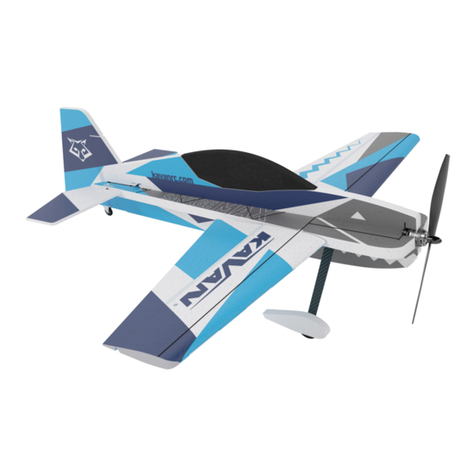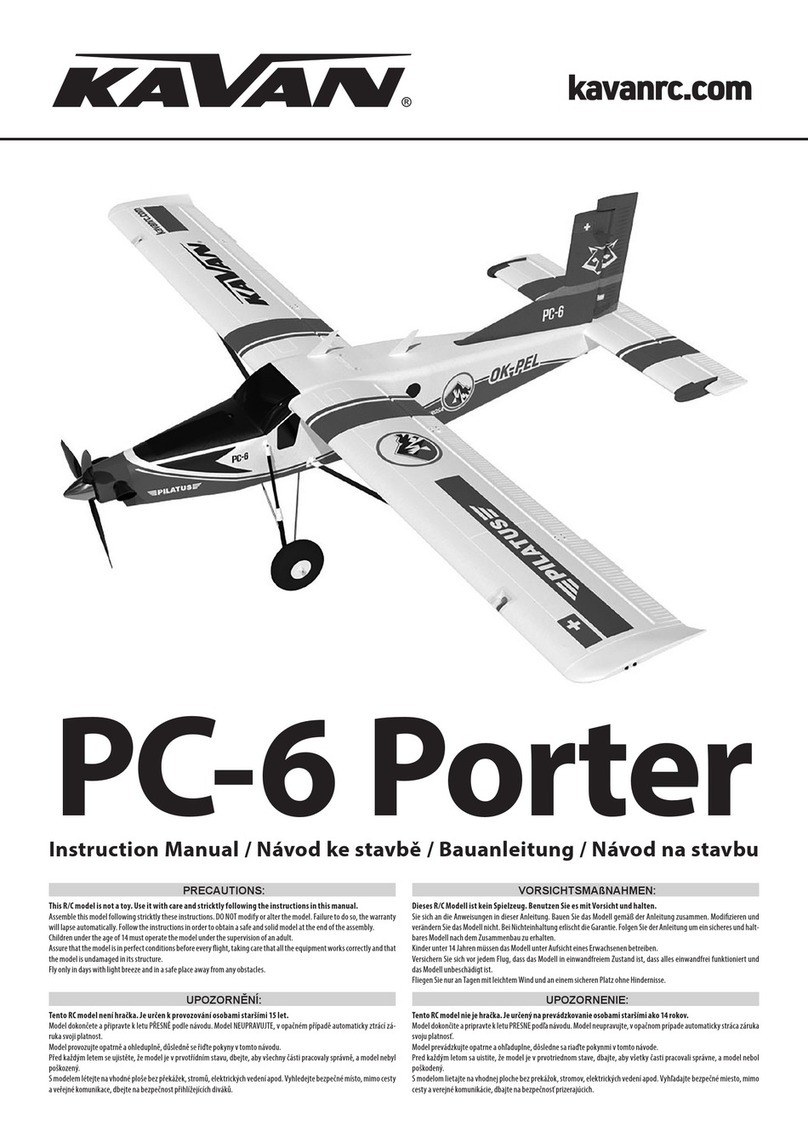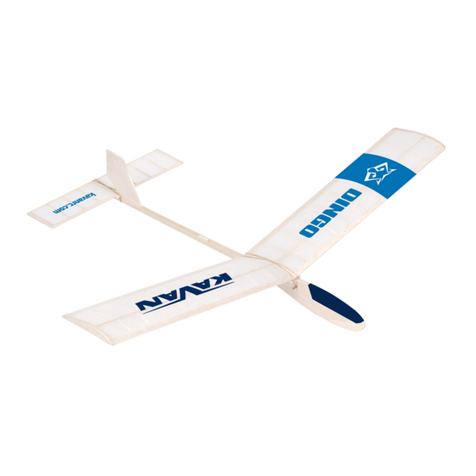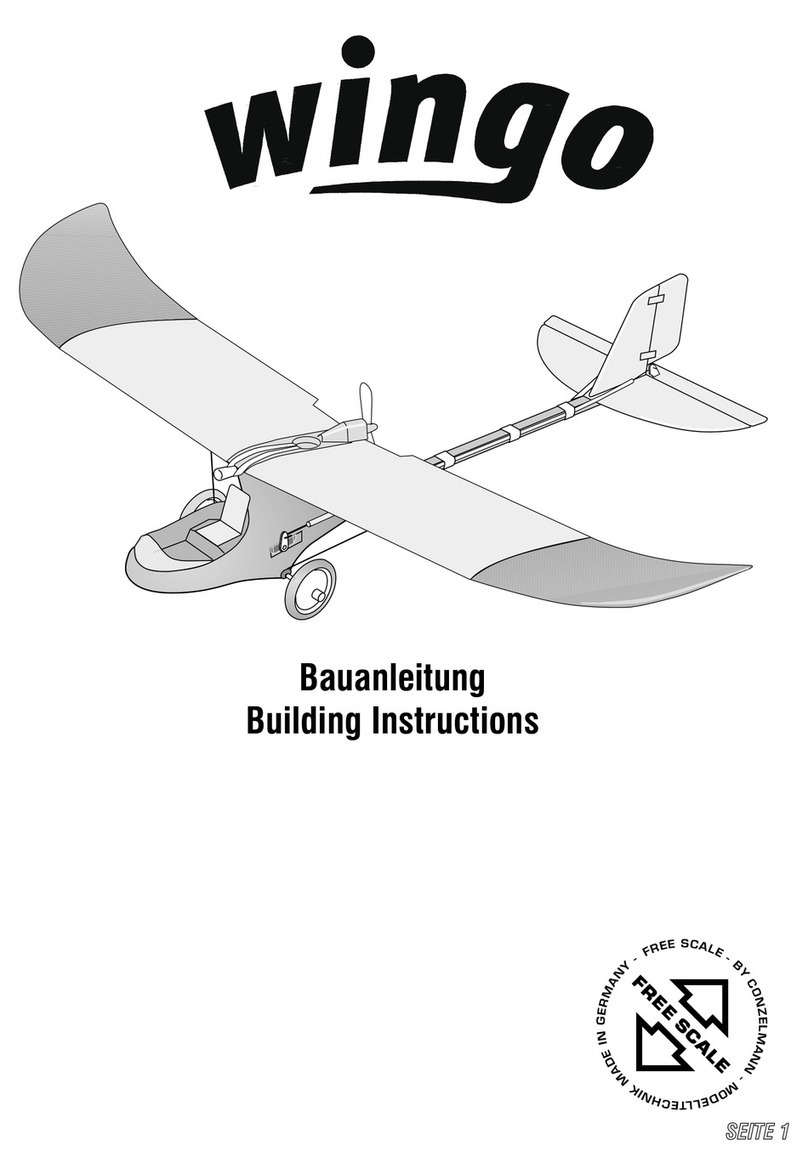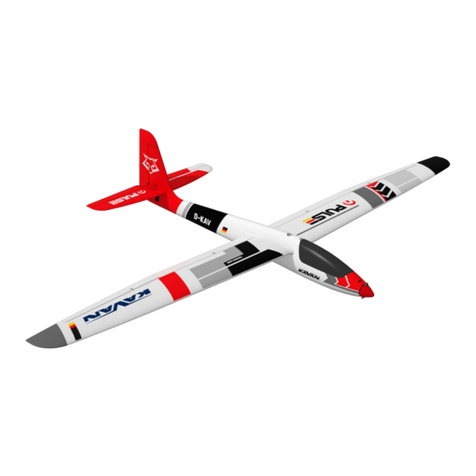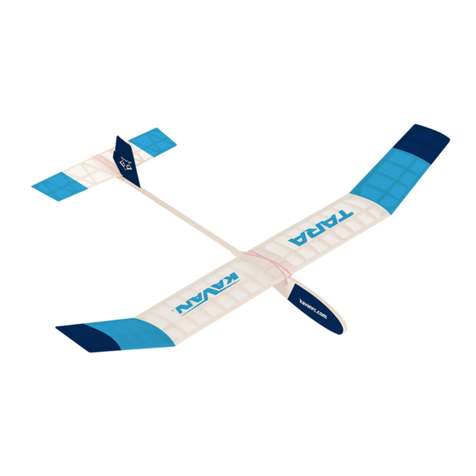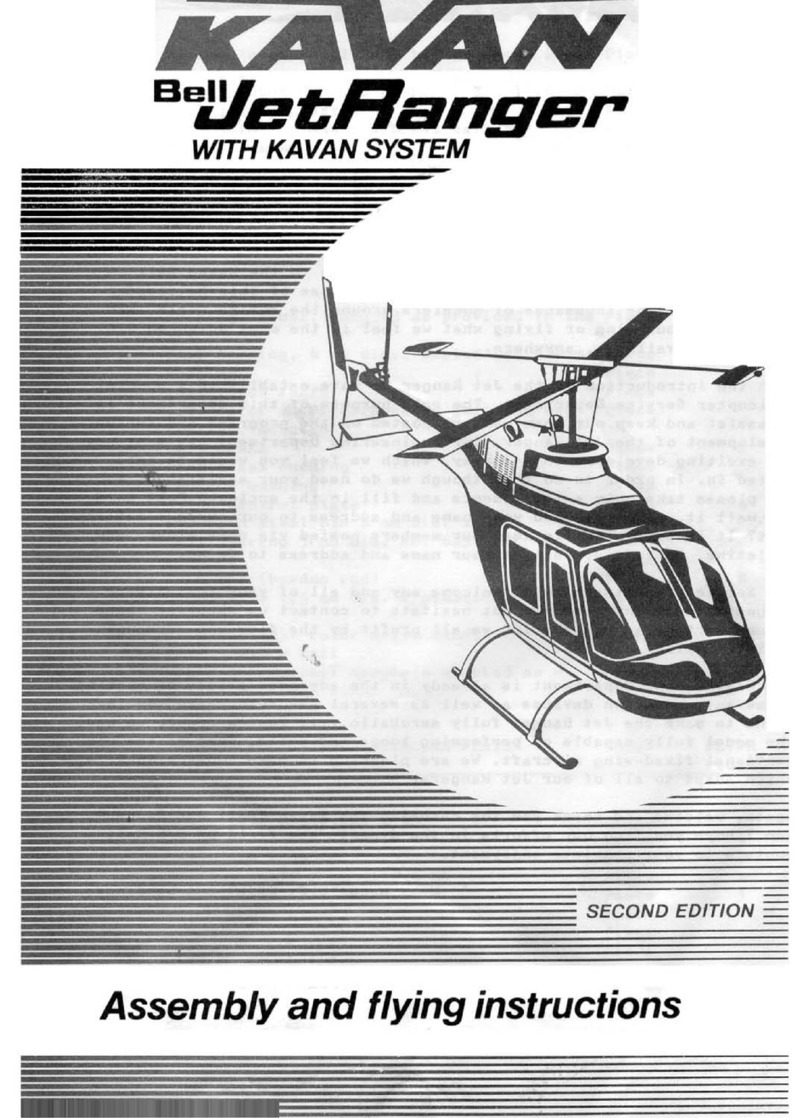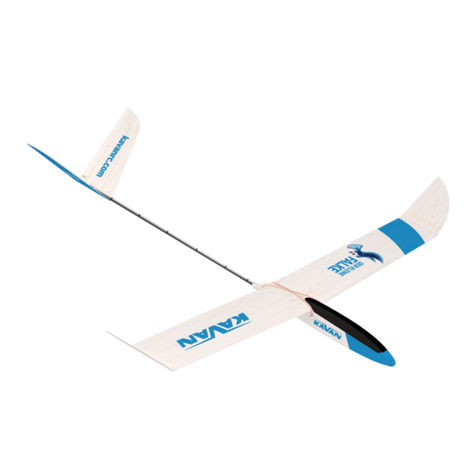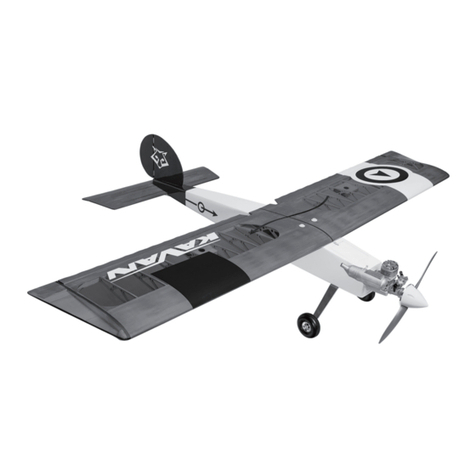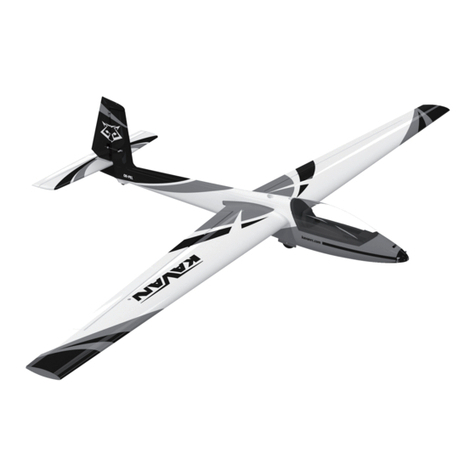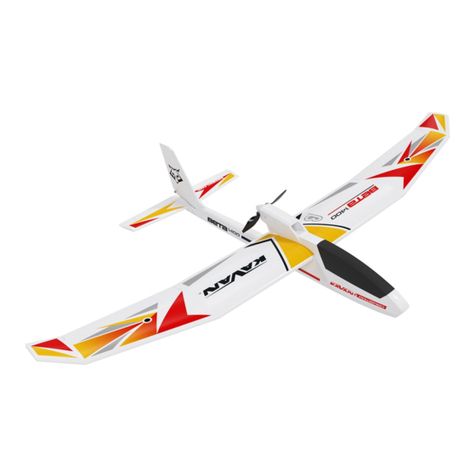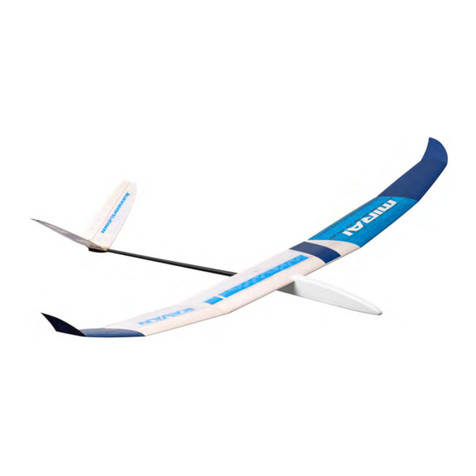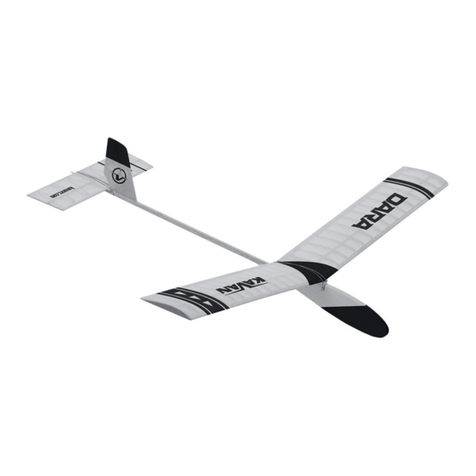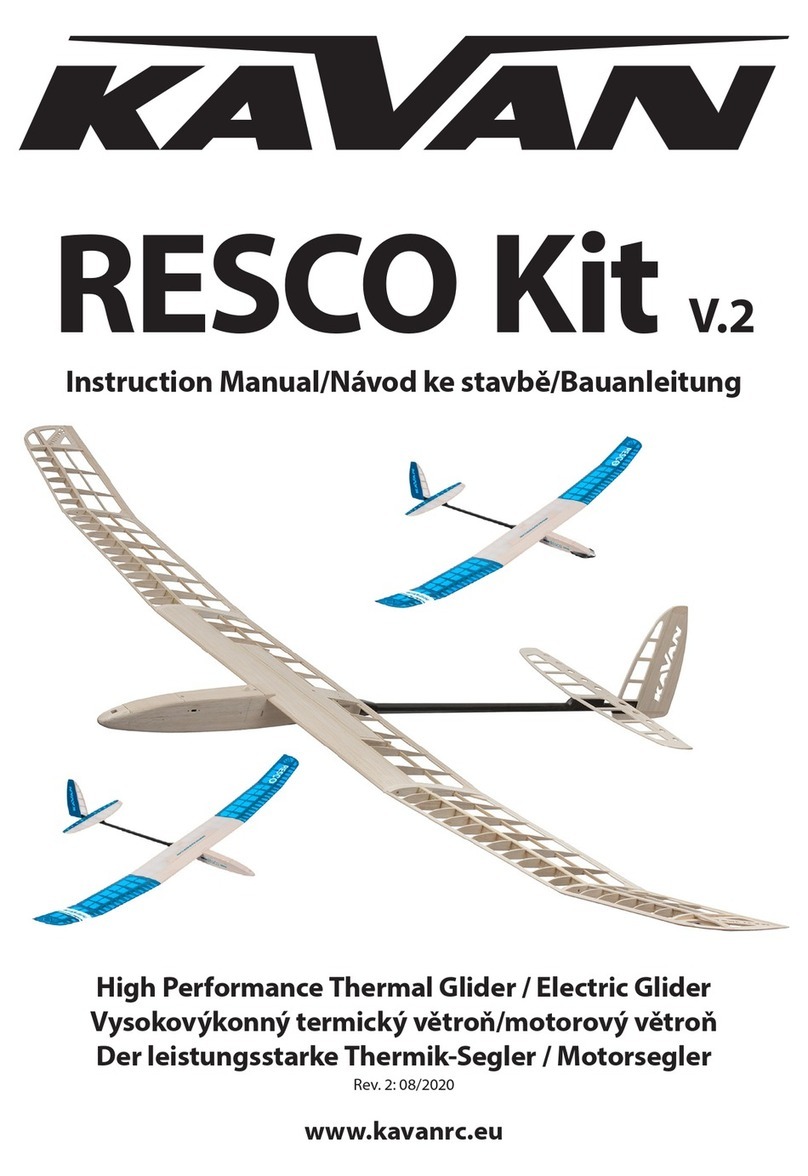
3
PŘEDLETOVÁ PŘÍPRAVA
Kontrola nastavení modelu
1. Ujistěte, že je ovladač plynu na vysílači zcela dole a vysílač zapněte. Páčky
všech trimů nastavte do středové polohy. K regulátoru otáček v modelu při-
pojte pohonný akumulátor.
2. Kontrola neutrální polohy a smyslu výchylek kormidel
Zkontrolujte, zda se křidélka, směrovka a výškovka nacházejí v neutrální
(středové) poloze, pokud jsou v neutrálu jejich ovladače na vysílači a přísluš-
né trimy ve středu. Tj. výškovka a směrovka musejí být v rovině s vodorov-
ným stabilizátorem resp. s kýlovkou a odtoková hrana křidélek musí být v
rovině s odtokovou hranou křídla. Pokud tomu tak není, opatrně povolte sta-
věcí šroub na variabilní koncovce na páce daného kormidla a nastavte délku
táhla tak, aby dané kormidlo bylo v neutrálu. Na stavěcí šroub naneste kapku
prostředku pro zajišťování šroubových spojů a stavěcí šroub opět pečlivě
dotáhněte.
POZOR: Pokud by za letu došlo k uvolnění táhla, model se může stát částeč-
ně nebo zcela neřiditelným a může dojít k havárii. Při případném nastavování
proto pracujte velmi pečlivě. Čas od času také kontrolujte stav táhel a ujistěte
se, že jsou spolehlivě upevněna k pákám serv.
3. Zkouška ovládání křidélek
A) Pokud nyní vychýlíte ovladač křidélek na vysílači směrem doleva, při po-
hledu na model zezadu se musí levé křidélko vychýlit nahoru a současně
pravé křidélko dolů.
B) Při vychýlení ovladače doprava se musí vychýlit levé křidélko dolů a pravé
nahoru. (Platí jednoduché pravidlo: Křidélko na té straně modelu, na kte-
rou vychylujete ovladač, se musí vychylovat nahoru.)
C) Ovladač křidélek vraťte do neutrálu (středové polohy) - křidélka se vrátí
do neutrální polohy, jejich odtoková hrana je v rovině s odtokovou hranou
křídla.
Pozn.: Pokud by se křidélka pohybovala v opačném smyslu, přepněte přepí-
nač smyslu výchylek na vysílači (AIL).
Pozn.: Máte-li vysílač s uspořádáním ovladačů v Módu 1, je ovladač plynu
vpravo. Na vysílači s ovladači uspořádanými v Módu 2 je plyn vlevo.
4. Zkouška ovládání směrovky
A) Pokud nyní vychýlíte levý ovladač na vysílači (směrovka) doleva, při pohle-
du na model zezadu se musí směrovka vychýlit doleva.
B) Při vychýlení ovladače směrovky vpravo se směrovka musí vychýlit doprava.
C) Ovladač směrovky vraťte do neutrálu (středové polohy) - směrovka se vrá-
tí do neutrální polohy, její odtoková hrana je v podélné ose trupu, v rovině
s kýlovkou.
Pozn.: Pokud by se směrovka pohybovala v opačném smyslu, přepněte pře-
pínač smyslu výchylek na vysílači (RUD).
5. Zkouška ovládání výškovky
A) Na vysílači v Módu 1 je ovladač výškovky vlevo, v Módu 2 napravo. Pokud
nyní vychýlíte ovladač výškovky dolů, při pohledu na model zezadu se
musí výškovka vychýlit nahoru - tzv. přitažení.
B) Při vychýlení ovladače výškovky nahoru se výškovka musí vychýlit dolů -
tzv. potlačení.
C) Ovladač výškovky vraťte do neutrálu (středové polohy) - výškovka se vrátí
do neutrální polohy, v rovině s vodorovným stabilizátorem.
Pozn.: Pokud by se výškovka pohybovala v opačném smyslu, přepněte pře-
pínač smyslu výchylek na vysílači (ELE).
6. Velikost výchylek kormidel
Pokud jste se řídili postupem popsaným v kapitole věnované stavbě modelu,
máte nyní již automaticky nastaveny správné velikosti výchylek všech kormi-
del, které jsou dány poměrem délky pák serva a délky pák kormidel (uvedeny
ve sloupci „Normální výchylky”). Vždy je nejlepší dosáhnout požadovaných
výchylek čistě mechanickou cestou - a to i v případě, že máte počítačovou
RC soupravu, která dovoluje velikost výchylek nastavovat programově. Má-
te-li počítačovou RC soupravu, můžete použít funkci „Dvojí výchylky” (D/R,
Dual Rate) pro získání ještě „tupějšího” nastavení, kdy BETA 1400 bude dale-
ko hodnější (uvedeno ve sloupci „Zmenšené výchylky”). Stejného výsledku
dosáhnete posunutím táhel na pákách serv blíže ke středu páky.
A. RC souprava s jedním kanálem pro křidélka
Kormidlo Zmenšené výchylky Normální výchylky Expo*
Křidélka 7 mm nahoru a dolů 10 mm nahoru a dolů 10-20%
Směrovka 10 mm vlevo a vpravo 12 mm vlevo a vpravo 0-10%
Výškovka 6 mm nahoru a dolů 8 mm nahoru a dolů 20-30%
B. RC souprava s křidélky ovládanými 2 kanály
Kormidlo Zmenšené výchylky Normální výchylky Expo*
Křidélka 8 mm nahoru/4 mm dolů 10 mm nahoru/5 mm dolů 10-20%
Křidélka
(Brzda) 13 mm nahoru 13 mm nahoru -
Směrovka 10 mm vlevo a vpravo 12 mm vlevo a vpravo 0-10%
Výškovka 6 mm nahoru a dolů 8 mm nahoru a dolů 20-30%
Výškovka
(Brzda) 2 mm nahoru 2 mm nahoru -
*Expo – nastavte pro zmenšení citlivosti okolo neutrálu (Futaba, Hitec, Radiolink,
Multiplex: -10/-20, Graupner: +10/+20 atd.)
7. Zkouška pohonné jednotky
Proveďte kalibraci rozsahu plynu regulátoru, jak je popsána v návodu k ob-
sluze vašeho regulátoru, a zkontrolujte, že je zapnuta brzda motoru.
A) Vysílač je zapnutý, ovladač plynu stažený zcela dolů, pohonný akumulá-
tor je připojen k regulátoru otáček v modelu. Pokud by se vrtule pomalu
otáčela, zkontrolujte, zda je ovladač plynu opravdu v poloze zcela dole
(vypnuto).
B) Pomalu vychylujte ovladač plynu nahoru, vrtule by se měla zvolna roz-
točit. Pozn.: Pokud by se vrtule neroztočila, zkontrolujte, zda je pohoný
akumulátor správně připojen a zda je plně nabitý. Zopakujte kalibraci roz-
sahu plynu.
C) Vrtule se musí při pohledu zezadu otáčet po směru hodinových ručiček.
Pokud tomu tak není, plyn stáhněte, odpojte pohonný akumulátor a na-
vzájem mezi sebou přepojte kterékoliv dva z trojice kablíků mezi moto-
rem a regulátorem.
POZOR: Pozor na otáčející se vrtuli! Pozor na prsty, volné části
oblečení! Nezastavujte otáčející se vrtuli rukou nebo jakýmkoliv jiným
předmětem.
8. Kontrola polohy těžiště (Obr. 16)
A) Těžiště u modelu BETA 1400 se nachází 70-75 mm za náběžnou hranou
křídla. Pro zalétávání umístěte pohonný akumulátor tak, aby těžiště bylo
70 mm za náběžnou hranou křídla. Pokud model v tomto místě v blízkosti
podepřete ukazováky, musí se ustálit s trupem ve vodorovné poloze.
B) Po zalétání můžete v souladu s vašimi zvyklostmi a stylem pilotáže polohu
těžiště doladit, posunutím vpřed se model stává stabilnějším, posunutím
vzad se model stává méně stabilním a citlivějším na řízení (těžiště by v
žádném případě nemělo být více vzadu než 80 mm).
INSTALACE RC SOUPRAVY
Nyní zbývá upevnit a zapojit přijímač, serva a elektronický regulátor otáček.
1. Sejměte kryt kabiny zvednutím jeho zadní části přidržované na místě mag-
netem. (Obr. 14)
Funkce Kanál přijímače (T8FB)
Křidélka CH1
Výškovka CH2
Plyn CH3
Směrovka CH4
2. Dle návodu k obsluze vaší RC soupravy zapojte kabely serv, regulátoru
otáček do přijímače – tabulka ukazuje zapojení přijímače při použití RC
soupravy T8FB dodávané v RTF setu
3. Přijímač vložte do prostoru v zadní části kabiny a upevněte k trupu např.
kouskem samolepícího suchého zipu.
4. Pohonný akumulátor budete vkládat do přídě, upevňuje se pomocí pásku
suchého zipu provléknutého pod překližkovou výztuhou - s tím vyčkejte
až na kontrolu polohy těžiště popsanou v následující kapitole.
POZOR: Vždy nejprve zapínejte vysílač a teprve potom připojujte po-
honný akumulátor. Od této chvíle vždy s modelem zacházejte tak, jako
kdyby se mohly motor a vrtule kdykoliv roztočit!
JDEME LÉTAT
VÝBĚR PLOCHY A POČASÍ PRO LÉTÁNÍ
Letová plocha
Letová plocha by měla být rovné travnaté prostranství. Neměla by se na ní
nacházet žádná vozidla, budovy, vedení elektrického napětí, stromy, velké
balvany nebo cokoliv jiného v okruhu asi 150 metrů (100 metrů je zhruba
délka fotbalového hřiště), do čeho by BETA 1400 mohla narazit.
Počasí pro létání
Dokud bezpečně nezvládnete pilotáž, doporučujeme létat pouze za bez-
větří nebo mírného vánku - ideální jsou klidné letní podvečery. BETA 1400
je model do klidného ovzduší s větrem pod 5 m/s. Nelétejte za deště, mlhy
nebo jinak snížené viditelnosti.

